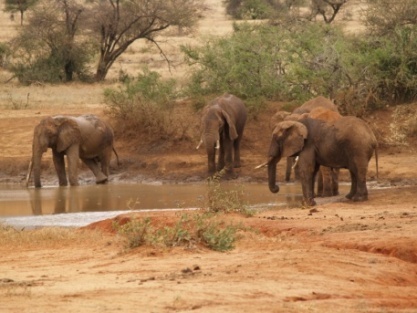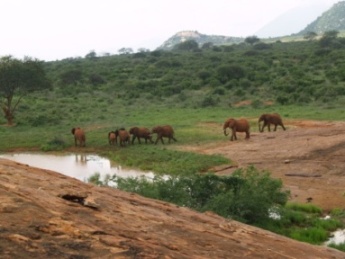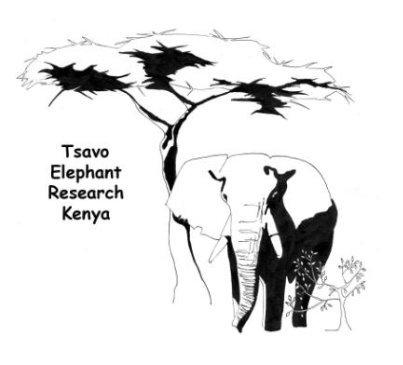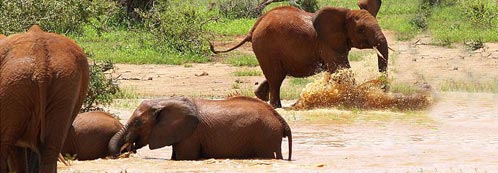Field Notes
January - April 2011
The Tsavo elephant aerial count was conducted by the Kenya Wildlife Service in early February. A total of 12,573 elephants were counted in the Tsavo Ecosystem (48,319 sq.km.). There were 9 aircraft and it took 5 days, sometimes all day to finish the allocated blocks. While the days were long, I enjoyed seeing Tsavo and the elephants from the air with many groups of bulls in my blocks.
It was hot and humid between January and April with heavy rainfall in mid-February and a few showers in March and April. A large flock of Carmine Bee-eaters arrived near Voi River in January, swooping around the feet of three aggregations of elephants; many of them tossed their trunk at the birds to get them to fly away.
Bulls
The waterholes in the bull area were full by mid-February and the vegetation was green with trees and shrubs flowering. Bulls associated in groups of four to five bulls and some were with families in small and large groups. By late April, bull group size increased from nine to 14 bulls per group.
In January, Sirius was in musth in an aggregation of families near Voi River. Then in February, he was not in musth, with Darwin and Moon in the northwest region. In March, Darwin was in musth with Skylight and a young male in a thick bush habitat traveling north. He often stopped at a tree and rubbed his temporal glands on the trunk of a tree. Skylight and the young male stayed behind Darwin following him north. In April Livingstone was with Amadeus, Knox and a young male resting under the shade of a Baobab. Holda’s family approached the bull group and moved close to Livingstone. Everyone shifted positions and then rested in the shade. There were no other families were in the area
Families
Many families aggregated in the western area surrounding the hills and in the open grassland area. Some families with small calves, less than one year old, were climbing the hills and feeding on the vegetation or drinking from pools in the rocks. In January Holda’s family, Medora’s family and Nelita’s family were together with Sunray (25 year old bull) at a waterhole in the northwest. A few days later Athena's family was alone at the same waterhole drinking and mud wallowing.
In early- April, Medora had a newborn; unfortunately the vegetation was too thick to determine the sex. In late-April, One Tusker’s family and Cypris’s family were together near Voi River, resting under a large Acacia. Cypris's male calf born last year in October looked healthy. Primrose’s family was also in this area feeding in the open grassland habitat. Chrystal's family was in the same area in an aggregation of 42, including two bulls (Sirius-in musth, Amadeus-not in musth).
May - September 2011
May and June were cool and windy, typical of dry season weather. By July most of the vegetation was dry and the natural waterholes in the north-western region were dry. There were a few showers in late September and within 72 hours some plants produced new shoots, and the temperature began to rise so hopefully the rains are on the way.
In August I saw a Fish Eagle feeding on a terrapin at the bank of a muddy waterhole. This is the third time I've seen this behavior. Also in August I found a male and female Somali Ostrich with seven small chicks. This was a surprise as I hadn't seen Ostrich chicks in this area for a long time. In early September a large flocks of over 200 Red-Billed Quelea were in the bull area.
Bulls
In May, Dart and Mathias, both 25 years old, were in musth. I suspect this was their first musth cycle as both of them dropped out of musth just a week later. Mathias appeared restless, moving one direction, stopped with his ears out and then turned and went the opposite direction toward a family of nine, who were moving toward him. When they were about 200 meters apart I could hear rumbling and as they got closer the rumbling got louder. When they met there was a lot of excitement: trumpeting and loud ear flapping. Then the family moved on and Mathias stayed where he was and watched them move away. Another family of 13 approached Mathias, rumbled and continued heading north.

In May Rudolf and Darwin were with a group of 16 bulls at a waterhole, drinking, mud-wallowing and resting. Some of them were close to the road, so I had to move out of their way because a couple of them didn't want me close. Keeping my eye on all of them was a bit difficult. I was relieved to see Rudolf, who I'd not seen since last year. Photo - Darwin far left, with crossed hind legs. Sandstone center and far right Dusk with Rudolf and a young male behind him.
In July Livingstone was with five bulls drinking and splashing at a waterhole. When Livingstone moved away from the waterhole along an elephant path, he stopped, picked up a branch, balanced it along the center, put it between his trunk and tusk, and then scratched between his front legs. He then dropped that stick, moved forward a few steps, picked-up another branch, a larger one this time, balanced it as before and scratched his inner leg. He manipulated the stick with such ease, balanced it and then scratched, that he must use a branch as a tool frequently.
Families
Many families aggregated around Voi and Wasesa hills, then moved north to Irima hill and the western grassland. A few weeks later some of them moved back to Wasesa Hill. In June Holda’s family and Hazel’s family were together on the western slope of Wasesa Hill. Then in August, Holda’s family was alone on the southern slope of Irima. A week later she had moved to the western slope of Mzinga Hill.
In July Eldora’s family and Tessa’s family were together with a musth bull in the western open grassland. Then in early-August Eldora's family was alone on the southern slope of Irima. Two weeks later, Eldora’s family was in the grassland west of Irima moving east. As they walked through the glade Eldora urinated and defecated and Sky's calf used her trunk to scoop-up the wet dung and wet grass from the urine and splash it behind her ears. I've seen this behavior before, by young elephants, during both the dry and rainy seasons.
In August, Athena’s family was east of the hills drinking from a leak in the water pipeline. The pipe had broken and water was flowing east into the bush for 150 meters creating a huge pool. More than 200 elephants, mostly families, were dispersed in this area for over three weeks.
October - December 2011
The rains started in mid-October and although they were patchy it rained heavily for a week in some areas and by late October it was hot and humid. It continued to rain every few days during November and December and the vegetation was green in most areas. Voi River went over the bank and flowed to the roads in many areas and the volume of water was so great that waves were produced. During the rains insects emerged from the ground in mid-November and large flocks of Barn Swallows arrived in Tsavo. Then in December the Eurasian Rollers arrived and many Chestnut Weavers began building nests. In the Voi River-grassland area a Spotted hyena walked across the open grassland but had to alter course as there was an elephant family feeding in the glade.
Bulls
Although the rains started in October most of the waterholes in the bull area remained dry until early December. Many bulls left the bull area and moved south to the Voi River. In mid-November many large groups of bulls (13, 11 and 9 bulls) were in the flooded grassland near the river. There were no families in the area; it was predominantly a bull area for almost one month. In November Livingstone left the bull area and moved south past Voi River. He was with Rasputin, who I had not seen in over a year. The next time I saw Rasputin he was alone at Kanderi feeding on grass.
Abydos (35-40 years old) was at a waterhole with three young bulls. When he left the waterhole the young males followed. As he walked along the trail he picked up a small stick and scratched his chin, similar to Livingstone behavior of tool-use. The stick Abydos used was small and when he scratched his chin it was a precise use of a tool.
In mid-December Darwin was southwest of Irima Hill in the open grassland with Dusk, a frequent companion and three young males. They were feeding on grass, herbs and vines. Nathan (35-40) was in a flooded area in the northwestern region of the bull area. I don’t see Nathan often, he tends to leave the bull area for over a year and then returns for a few days and then leaves again.
Families
Since most of the early rains stated in the southern region of Tsavo East, many families moved south. But, once the rains were more widespread families dispersed throughout Tsavo. In October Eldora’s family was following Isaac (45-50 years old) to a waterhole. Isaac drank for a short time then moved to the shade of a Baobab. Once the family drank and splashed they moved toward Isaac and joined him in the shade of the tree.

In late-December, Primrose’ s family was in the far northwestern area of her range, on the west side of Mudonda Rock. As the family got closer to the waterhole the calves rushed forward to the water. They stayed at the waterhole for only 15 minutes then headed north to a thick tree-bush habitat.
Also in December Holda’s family and Hazel’s family were together following Lunar (40-45 years old) through an open grassland habitat toward a group of Acacias. Lunar stopped in the shade of one tree and the family moved close to him. They rested for 50 minutes and then with Lunar in the lead again they moved north feeding on grass and herbs.

Tsavo Elephant Research Needs Your Help.
Donations are needed to continue this 30+ year field study
and support a Kenyan research field team.
We monitor the behaviors of Tsavo known bulls and families:
group dynamics, offspring & survival, musth cycles and habitat use.
Please click here or on the donate button
to send your donation.
Thank you!
Barbara
